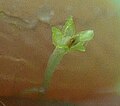
Conyza is a genus of flowering plants in the family Asteraceae.
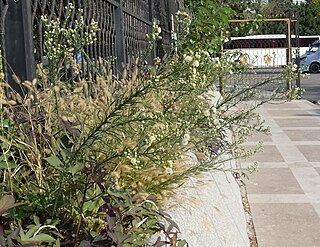
Erigeron bonariensis is a species in the family Asteraceae, found throughout the tropics and subtropics as a pioneer plant; its precise origin is unknown, but most likely it stems from Central America or South America. It has become naturalized in many other regions, including North America, Europe and Australia.

Erigeron canadensis is an annual plant native throughout most of North America and Central America. It is also widely naturalized in Eurasia and Australia. Common names include horseweed, Canadian horseweed, Canadian fleabane, coltstail, marestail, and butterweed. It was the first weed to have developed glyphosate resistance, reported in 2001 from Delaware.

Erigeron compositus is an Arctic and alpine species of fleabane in the family Asteraceae. Common names include dwarf mountain fleabane, cutleaf daisy, and trifid mountain fleabane.

Erigeron philadelphicus, the Philadelphia fleabane, is a species of flowering plant in the composite family (Asteraceae). Other common names include common fleabane, daisy fleabane, frost-root, marsh fleabane, poor robin's plantain, skervish, and, in the British Isles, robin's-plantain, but all of these names are shared with other species of fleabanes (Erigeron). It is native to North America and has been introduced to Eurasia.

Erigeron annuus, the annual fleabane, daisy fleabane, or eastern daisy fleabane, is a species of herbaceous, annual or biennial flowering plant in the family Asteraceae.
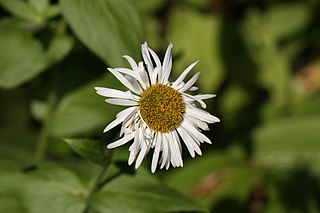
Erigeron aliceae is a species of flowering plant in the family Asteraceae known by the common name Alice Eastwood's fleabane, or simply Alice's fleabane. It was named for American botanist Alice Eastwood, 1859 - 1953.

Erigeron compactus is a species of flowering plant in the family Asteraceae known by the common names cushion daisy, fernleaf fleabane, and compact daisy.
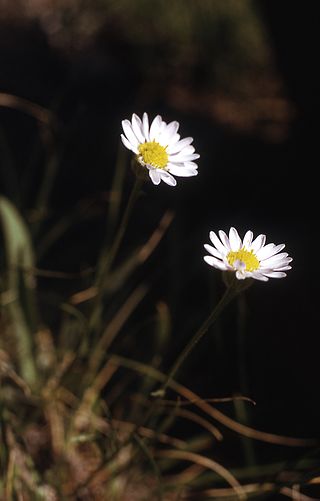
Erigeron eatonii is a North American species of flowering plants in the family Asteraceae known by the common name Eaton's fleabane.
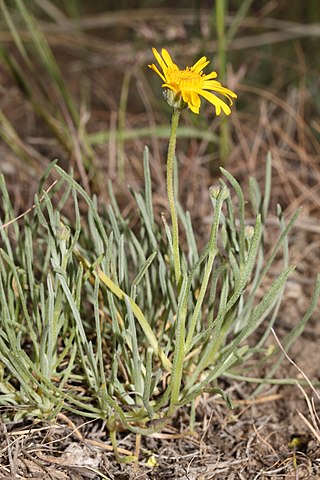
Erigeron linearis is a species of flowering plant in the family Asteraceae known by the common name desert yellow fleabane or narrow leaved fleabane. It is native to western North America.

Erigeron strigosus is a species of flowering plant in the family Asteraceae known by the common names prairie fleabane, common eastern fleabane, and daisy fleabane.

Erigeron vagus is a high-elevation species of flowering plant in the family Asteraceae known by the common names rambling fleabane.

Erigeron maniopotamicus is a rare species of flowering plant in the family Asteraceae known by the common name Mad River fleabane. It is endemic to northwestern California, where it is known from only four locations in Humboldt and Trinity Counties.

Erigeron pumilus, the shaggy fleabane, or vernal daisy, is a hairy North American species of perennial plants in the family Asteraceae. It is widespread across much of western Canada and the western United States, from British Columbia east to Saskatchewan and south as far as Oklahoma and the San Bernardino Mountains of California. There have been reports of the plant growing in Yukon Territory, but these were based on misidentified specimens.

Erigeron poliospermus is a species of flowering plant in the family Asteraceae known by the common names gray-seeded fleabane, purple cushion fleabane, and hairy-seed fleabane. Native to western North America, it is mainly found to the east of the Cascade Range in Washington, Oregon, and Idaho.

Erigeron speciosus is a widespread North American species of flowering plants in the family Asteraceae known by the common names aspen fleabane, garden fleabane, and showy fleabane.

Erigeron tweedyi, or Tweedy's fleabane, is a perennial herb in the family Asteraceae. It is native to the Rocky Mountains in Montana, Idaho and Wyoming.
Erigeron floribundus is an annual/biennial plant native to South America to Mexico and introduced to many parts of the world. Its common names include tall fleabane, Bilbao's fleabane, and many-flowered fleabane.





